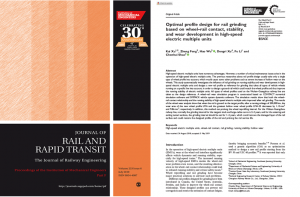High-speed electric multiple units have numerous advantages. However, a number of critical maintenance issues arise in the operation of high-speed electric multiple units. The previous researches about rail profile design usually take only a single type of wheel profile into account, which would cause some other problems such as severe increase of hollow wear on the wheels. This study systematically investigates the influence of rail grinding on running stability and wear development in highspeed electric multiple units and designs a new rail profile as reference for grinding that takes all types of vehicle wheels running on a specific line into account, in order to design a ground rail which could match the wheel profile and thus improve the running stability of electric multiple units. All types of wheel profiles used on the Wuhan–Guangzhou railway line are taken as the design reference. A wheel–rail wear simulation program is constructed based on CONTACT numerical simulation software and SIMPACK vehicle system dynamics software. The simulation results show that both the wheel-rail contact relationship and the running stability of high-speed electric multiple units improved after rail grinding. The results of the wheel wear analysis show that when the rail is ground to the target profile, after a running mileage of 200,000 km, the wear area of the new wheel profile LMA and the greatest hollow wear wheel profile LMA-25 decreases by 1.13 mm2 and 9.86 mm2, respectively. In addition, this method can prolong the wheel reprofiling interval. For the Wuhan–Guangzhou railway line, normally the grinding interval for the tangent track and large-radius curve is 2–3 years, and for the entering and exiting tunnel sections, the grinding interval should be set for 1–2 years, which could remove the damaged layer of the rail surface and could restore the designed profile of the rail and prolong the rail service life.
Read the paper here.
